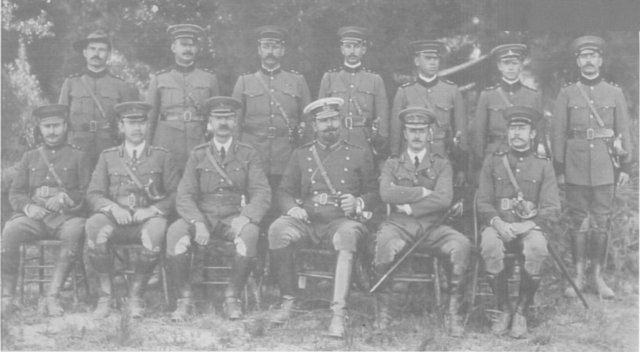

 The South African
The South African
The new Union Defence Force (created by the Union of South Africa Defence Act of 1912) was to draw its personnel from former members of both sides that fought in the Anglo-Boer War. The war had ended on 31 May 1902 - only a decade before the creation of the new defence organisation - and memories of the war were still quite strong. Many Dutch/Afrikaans-speaking South Africans had no desire to wear what they perceived to be the 'uniform of the conqueror' (L Jooste, 1996). The Defence Council, which included members of both the former Boer forces and the former Colonial forces approved the new uniform, as did the Commandant-General of the Citizen Force, Brig Gen C F Beyers (PM 51/44/1916). The Defence Council included Jan Smuts, Louis Botha and Schalk Burger of the former Boer forces; and Sir Charles Crewe and Sir Duncan Mackenzie of the former Colonial forces.
ACF regiments that had been established for some time (ie, former Colonial units) and that already wore khaki uniforms were allowed to retain them along with their regimental facings (if they had any). The UDF, however, also created some new, numbered, ACF regiments of Mounted and Dismounted Rifles (Tylden, 1954). These new units were to be kitted out in the new drab and green uniform.

Private, South African Citizen Force, 1913
(Based on sketch in the Nongqai magazine, December 1913, p 81).
The colour of the new uniform was a green-brown mixture known as 'drab'. Official correspondence also referred to it as being a 'heather mixture' (PM 51/44/ 1916). No existing example of this uniform could be traced by the writer to verify the actual colour - even the prestigious South African National Museum of Military History in Johannesburg does not possess an example. A couple of black and white photographs (Ref Nos 31232 and 32234) found the National Archives in Pretoria provide some clues. From these photographs, it would appear that the 'drab' colour was very similar to the colour of the familiar barathea four-pocket service dress jackets worn during the First and Second World Wars. The collars and cuffs appear to have been dark green. The fact that most of the new units were rifle units tends to support the choice of a dark shade of green. Cap bands were also green.
Despite providing South African soldiers with a distinctive identity, the new uniform did not prove popular. It seems that some members of old ex-Colonial units thought it 'not khaki enough' while some members of the former Boer forces thought it 'too khaki' in appearance! The First World War (1914-1918) interrupted wholesale introduction of the new uniform and it was subsequently confined to history.

Group of Union Defence Force officers c 1913-14
Most are wearing the new Active Citizen Force drab uniform with dark green facings & cap bands.
Colonels Bouwer, Brits & an unidentified staff officer are wearing the more familiar service dress jacket with step collar.
Brig-Gen Beyers (seated at centre) is wearing a blue frock coat that was part of the dress options for senior officers at the time.
(Photo: National Archives, Pretoria, Ref: 31232)
About the author
Mark Naude is a member of the South African Military History Society as well as the Society for the Preservation of Militaria. He collects militaria and his particular interest is in uniforms and badges. He also enjoys researching military units and personalities of
South African interest.
REFERENCES
National Archives, Pretoria
Prime Minister (PM), Volume 1/1/155, File No PM51/44/ 1916: Defence: The Defence Forces uniform.
URU, Volume 152, Reference No 2196: Payment for the uniform of the Commandant General, Citizen Forces. Photograph collection: Photo Nos 31232 & 32234.
Publications
Jooste, L, 'Die politiekekoerswending van 1948 besorg 'n nuwe identiteit aan die Unieverdedigingsmag' in Militaria, 26/2, 1996.
Tylden, G, Armed Forces of South Africa (Frank Connock/ Africana, Johannesburg, 1954).
Return to Journal Index OR Society's Home page
South African Military History Society / scribe@samilitaryhistory.org